How to Perform a System Description

In aviation, safety is the top priority, and managing risks effectively is essential to protect passengers, crew, and aircraft. A key element of this process is the system description, a detailed outline of an aviation organization’s operations, components, and interactions. This document serves as the foundation for identifying hazards and assessing risks within the Safety Risk Management (SRM) Pillar of a Safety Management System (SMS).
According to the International Civil Aviation Organization (ICAO), a system description is critical for understanding operational environments and ensuring safety (ICAO SMM). This article provides a comprehensive guide for aviation safety managers on how to perform a system description and explores how SMS Pro, a leading aviation safety software, facilitates this process. Designed to be evergreen, this guide offers timeless principles and practical advice to enhance safety management.
What Is a System Description in Aviation SMS?
Definition and Purpose
A system description is a comprehensive summary of an aviation organization’s processes, activities, and interfaces, as outlined in the ICAO Safety Management Manual (SMM), Part III, Chapter 2 (ICAO SMM). It defines the scope of the SMS, identifies operational components, and serves as the starting point for hazard identification and safety risk assessment. By documenting the system, safety managers gain a clear understanding of how different parts of the operation interact, enabling them to pinpoint potential risks.
Key Components
A robust system description typically includes:
- Scope of Operations: The specific activities covered by the SMS, such as flight operations, maintenance, or ground handling.
- Operational Components: Aircraft types, equipment, personnel roles, training programs, and regulatory requirements.
- Interactions: How components interact, such as coordination between pilots and maintenance teams.
- Processes: Detailed procedures, like pre-flight checks or emergency response protocols.
- Interfaces: Connections with external entities, such as air traffic control, airports, or suppliers, as well as internal departments managing or monitoring hazards.
Importance in Risk Management
The system description is integral to the SRM Pillar, one of the four components of an SMS, alongside Safety Policy, Safety Assurance, and Safety Promotion (FAA SMS). It provides the context needed to identify hazards, assess their likelihood and severity, and implement effective controls. Without a thorough system description, safety managers may overlook critical risks, leading to potential accidents or regulatory non-compliance.
Related Aviation Risk Management Articles
- Difference Between Hazards, Risks & Control Measures in Aviation SMS
- How to Identify Hazards and Assess Risks in Aviation SMS - With Free Resources
- Difference Between Hazards and Risks in Your Aviation SMS
Steps to Perform a System Description
Creating a system description requires a structured approach to ensure all relevant aspects of the operation are documented. Below are the key steps, based on industry standards and best practices.
1. Define the Scope
Determine which parts of the organization or operation the SMS will cover. For a regional airline, this might include flight operations, maintenance, and crew training, but exclude unrelated activities like marketing. Clearly defining the scope ensures the system description is focused and manageable.
2. Identify Key Components
List all critical elements of the operation, including:
- Aircraft and Equipment: Types, specifications, and maintenance schedules.
- Personnel: Roles, qualifications, and training requirements for pilots, mechanics, and ground staff.
- Procedures: Standard operating procedures (SOPs) for flight, maintenance, and emergencies.
- Regulations: Compliance with national and international standards, such as FAA or ICAO requirements.
- External Factors: Environmental conditions, like weather, or operational constraints, like airport infrastructure.
3. Describe Interactions

Explain how these components interact within the system. For example, how do pilots communicate with air traffic control? How does maintenance scheduling affect flight operations? Mapping these interactions helps identify potential points of failure or risk.
4. Document Processes
Provide detailed, step-by-step descriptions of operational processes. For instance, outline the pre-flight inspection process, including who performs it, what checks are conducted, and how findings are reported. This level of detail is essential for identifying procedural gaps that could lead to hazards.
5. Identify Interfaces
Note any external systems or organizations that interact with the operation, such as:
- Airports and their ground handling services.
- Maintenance contractors or parts suppliers.
- Regulatory bodies like the FAA or EASA.
- Air traffic control and navigation services. These interfaces can introduce additional risks that need to be managed.
Related Articles on Interfaces in Aviation SMS
- How to Identify Interfaces in Aviation SMS Scenarios
- Understanding Importance of Interfaces in Aviation SMS
- How to Review Management of Change Interfaces in Aviation SMS
6. Update Regularly
A system description is not a one-time task. It must be reviewed and updated regularly to reflect changes in operations, equipment, regulations, or after significant incidents. Scheduling periodic reviews ensures the description remains accurate and relevant.
Example: System Description for a Regional Airline
Consider a hypothetical regional airline operating a fleet of turboprop aircraft. Its system description might include:
- Fleet: 10 ATR 72-600 aircraft, each with specific performance capabilities and maintenance requirements.
- Routes: Short-haul flights to 15 regional airports, with considerations for weather and runway conditions.
- Personnel: 50 pilots, 30 cabin crew, and 20 maintenance technicians, all trained to FAA standards.
- Procedures: SOPs for flight operations, including pre-flight briefings and emergency evacuations.
- Interfaces: Coordination with regional airports, fuel suppliers, and FAA inspectors.
This description provides a clear picture of the operation, enabling safety managers to identify risks like weather-related delays or maintenance scheduling conflicts.
How SMS Pro Facilitates the System Description Process
Overview of SMS Pro
SMS Pro is a web-based software solution designed to support aviation organizations in implementing and managing their aviation SMS. Since 2008, it provides a centralized platform for hazard reporting, risk management, and compliance with ICAO and FAA standards. Its user-friendly interface and robust features make it an invaluable tool for aviation safety managers tasked with creating and maintaining system descriptions. SMS Pro is the first aviation SMS specific application to be marketed to address ICAO's Nov 2006 SMS mandate.
Key Features Supporting System Description
SMS Pro offers several modules that streamline the system description process, based on information from its official website. These include:
| Feature | Description | Benefit for System Description |
|---|---|---|
| Proactive Hazard Identification | Dedicated module to compose system description, identify hazards, risks, controls and interfaces | Ensures the system description is organized and easily accessible when identifying hazards. Provides templates to ease writer's block and stimulate brain storming. |
| Hazard Risk Registers | Tools to document and track hazards, risks, and control measures' effectiveness. | Links hazards to specific system components, enhancing risk identification. |
| Management of Change | Documents system changes and assesses their safety impact. | Keeps the system description current by tracking operational changes. |
| Data Analysis and Reporting | Analyzes safety data and generates reports for audits or management reviews. | Validates the system description with real-world performance data. |
| Centralized Documentation | Stores all SMS-related information in one accessible platform. | Ensures the system description is organized and easily accessible. |
| Collaboration Tools | Allows multiple users to contribute and review SMS documentation. | Promotes comprehensive input from stakeholders across the organization. |
Practical Application
Using SMS Pro, safety managers can:
- Input System Details: Enter information about aircraft, personnel, and procedures into structured templates, ensuring all necessary components are covered.
- Link to Hazard Identification: Use hazard risk registers to associate identified risks with specific parts of the system description, creating a direct connection between the operation and its safety measures.
- Track Changes: When operational changes occur, such as adding a new aircraft type, the Management of Change module prompts a review of the system description and assesses potential safety impacts.
- Generate Reports: Produce reports that include system description details for regulatory audits or internal reviews, ensuring compliance and transparency.
- Facilitate Collaboration: Allow team members from different departments to contribute to the system description, ensuring it reflects diverse perspectives and expertise.
- Bowtie Integration: Allows safety professionals to visualize risk assessments and corrective actions for top hazard events.
Related Aviation SMS Bowtie Articles
- What, Why, and How to Use Bowtie Analysis in Aviation SMS
- How to Do Bowtie Analysis in Aviation SMS – 5 Step Walkthrough
- 3 Ways You’re Not Using the Bowtie in Aviation SMS
Benefits of Using SMS Pro Writing System Descriptions
- Efficiency: Streamlines the documentation process, saving time compared to manual methods like spreadsheets.
- Accuracy: Reduces errors by providing structured templates and automated workflows.
- Accessibility: Enables real-time access to the system description from anywhere, supporting remote collaboration.
- Compliance: Aligns with ICAO and FAA requirements, helping organizations meet regulatory standards. Very audit worthy, documenting management reviews and approvals.
- Integration: Connects the system description to other SMS processes, like hazard identification, risk assessment, control measures and interfaces for a cohesive safety management approach.
Example Scenario
Imagine a safety manager at the regional airline mentioned earlier. They use SMS Pro to document their system description, entering details about their ATR 72-600 fleet and flight operations. When a new route is added, the Management of Change module alerts them to update the system description and assess risks like unfamiliar airport procedures.
The Management of Change (MOC) module integrates with hazard risk register to link a potential hazard—such as runway incursions—to the new route, prompting the development of additional training. New hazards can be added directly from the MOC module, prompting further risk assessment and risk control development. This integrated approach ensures the system description remains a living document that drives safety improvements.
Best Practices for Aviation Safety Managers

To create an effective system description, safety managers should follow these best practices, drawn from industry standards and practical experience:
Involve All Relevant Stakeholders
Engage personnel from across the organization, including pilots, maintenance technicians, ground staff, and management. Their insights ensure the system description is comprehensive and reflects real-world operations. For example, pilots can highlight procedural challenges, while maintenance staff can detail equipment limitations.
Use Visual Aids
Incorporate diagrams, flowcharts, or mind maps to represent complex processes and interactions. A flowchart of the pre-flight inspection process, for instance, can make it easier to identify potential risks like missed checks. SMS Pro’s platform supports uploading such visuals and other supporting documentation for easy reference.
Conduct Regular Reviews
Schedule periodic reviews of the system description, especially after significant changes like new regulations, equipment upgrades, or incidents. A quarterly review cycle, supplemented by ad-hoc updates, helps maintain accuracy. SMS Pro’s automated alerts can remind managers of review deadlines. Hazards requiring review can be easily reviewed in a safety committee meeting using SMS Pro's Meeting Manager.
Ensure Accessibility
Make the system description available to all relevant employees, either through SMS Pro’s web-based platform or other secure means. Accessibility ensures that staff can refer to it for safety-related decisions, such as during incident investigations or training sessions.
Align with Regulatory Standards
Ensure the system description meets requirements from regulatory bodies like the FAA or EASA. Referencing documents like the FAA’s Advisory Circular 120-92D (FAA AC 120-92D) or ICAO SMM can guide compliance efforts.
Challenges and Solutions
Creating and maintaining a system description can present challenges, but SMS Pro offers solutions to address them:
| Challenge | Solution With SMS Pro |
|---|---|
| Keeping the Description Updated | Management of Change module tracks changes and prompts reviews, ensuring ongoing accuracy. |
| Ensuring Comprehensive Input | Collaboration tools allow multiple stakeholders to contribute, reducing oversight risks. |
| Managing Complex Data | Centralized documentation and templates simplify data organization and retrieval. |
| Meeting Regulatory Requirements | Reporting tools generate audit-ready reports that align with ICAO, FAA and EASA standards. |
Conclusion
A thorough system description is the cornerstone of effective risk management in aviation safety. It provides the clarity needed to identify hazards, assess risks, and implement controls, ultimately preventing accidents and ensuring compliance with international standards.
SMS Pro enhances this process by offering a user-friendly, integrated platform that streamlines documentation, tracks changes, and supports collaboration. By following the steps outlined in this guide and adhering to best practices, aviation safety managers can create a robust system description that strengthens their SMS and promotes a culture of safety.
Whether managing a small flight school or a large airline, tools like SMS Pro empower safety professionals to protect their operations and achieve excellence in aviation safety.







